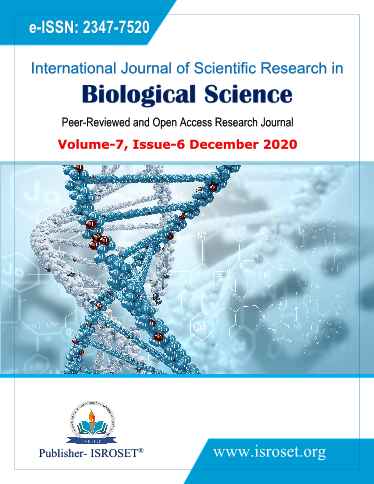The Effect of Armed Conflict on Biodiversity and its Implication on Wildlife: A Case Study on the Lebialem Highlands, South-West Region, Cameroon
Keywords:
Conflict, Biodiversity, Wildlife, Habitat-loss, Lebialem HighlandsAbstract
The armed conflict in the Anglophone regions of Cameroon surged in 2016. In this conflict, many villages have been razed and hundreds of thousands of people displaced. In the South West Region, Lebialem is one of the hot zones of the conflict. Here, many displaced persons have found refuge in the forest; their impact on biodiversity cannot be undermined. The goal of this research paper is to highlight the impact of the armed conflict on the biodiversity and its implications for wildlife. In order to achieve this goal, the land cover of the study site was analyzed using satellite imagery. Two Landsat 8 OLI_TIRS satellite images taken in 2015 and 2020 were downloaded through the United States Geological Survey (USGS). These two images were processed using ENVI 5.3. Maps were produced by importing vectors derived from digital processing ENVI into Arc Map 10.5 software. A wildlife survey was conducted using the guided reconnaissance (recce) method. The results indicate that there was a slight change in dense forest cover of 0.26% (152 ha) and a general decrease in the relative abundance of Nigeria-Cameroon chimpanzee (from 2.964 in 2015 to 0.321 in 2018), Cross River gorilla (from 1.857 in 2015 to 0.107 in 2018), African forest elephants, and other species whose populations are vulnerable to human disturbance. Though armed conflict might have its own impacts on biodiversity and wildlife species, a strong conservation program is needed for the development of local professionals to continue even during socio-political instability.
References
T. Hanson, T.M. Brooks, da Fonseca, GAB, “Warfare in biodiversity hotspots,” Conserv Biol. Vol. 23, pp.578–87, 2009.
Dudley, J.P., Ginsberg J.R., Plumptre A.J., Hart J.A., and Campos L.C, “Effects of war and civil strife on wildlife and habitats,” Conserv. Biol. Vol.16, Issue.2, pp. 319–329, 2002. doi:10.1046/j.1523-1739.2002.00306.
G.E. Machlis and T. Hanson, “Warfare ecology,” BioScience, Vol.58, pp 729–736, 2008. doi:10.1641/B580809.
S. Kanyamibwa, “Impact of war on conservation: Rwandan environment and wildlife in agony,” Biodiversity and Conservation, Vol.7, pp. 1399 –1406, 1998.
N. P. Gleditsch, “Armed Conflict and the Environment,” Journal of Peace Research, Vol.35, Issue.3, pp.381-400, 1998.
Shambaugh, J., Oglethorpe, J. and R. Ham, “The Trampled Grass: Mitigating the impacts of armed conflict on the environment,” Washington, DC. USA: Biodiversity Support Program, Grammarian Inc, pp. i-109, 2001.
J.A. McNeely, Biodiversity, “War and Tropical Forests,” Journal of Sustainable Forestry, Vol.16, Issue. (3/4), pp. 1-20, 2003.
J.H Daskin and R.M. Pringle, “Warfare and wildlife declines in Africa’s protected areas,” Nature, Vol.553, pp. 328-332, 2018.
S. Gartlan, “The conservation of forest ecosystems in Cameroon,” IUCN, Gland, Switzerland and Cambridge, United Kingdom, pp ix-186, 1989.
S. Gartlan, “La conservation des ecosystems foréstier du Cameroun, IUCN, Gland, Suisse et Cambridge, Royaume-Uni, pp ix-186, 1989.
S.D. Davis, V.H. Heywood, A.C Hamilton. “Centre of plant diversity: a guide and strategy for their conservation, Europe South West Asia and the Middle East Africa,” IUCN and WWF, Cambridge, Vol 1, pp.1-368, 1994.
B. Groombridge, and M.D. Jenkins, “World Atlas of Biodiversity,” Prepared by the UNEP World Conservation Monitoring Centre, University of California Press, Barkley USA, pp. xi-344, 2002.
M. Arun, K. Sananda K. C. Surendra, S. Rituraj, P.K. Mishra, “Comparison of Support Vector Machine and Maximum Likelihood Classification Technique using Satellite Imagery,” International Journal of Remote Sensing and GIS, Vol.1, Issue. 2, pp.116-123, 2012.
P.D. Walsh, and L.J.T. White, “What will it take to monitor forest elephant populations,” Conservation Biology, Vol.13, pp.1194–1202, 1999.
H. Kuhl, F. Maisels, M. Ancrenaz, & E.A. Williamson, “Best practice guidelines for surveys and monitoring of great ape populations,” Occasional Papers of the IUCN Species Survival Commission, Vol.36, pp.1-28, 2008.
A. McNeilage, M.M. Robbins, M. Gray, W. Olupot, D. Babaasa, R. Bitariho, A. Kasangaki, H. Rainer, S. Asuma, G. Mugiri, J. Baker, “Census of the mountain gorilla gorilla beringei beringei population in bwindi impenetrable national park, uganda” Oryx, Vol.40, pp.419-427, 2006.
C. E. G. Tutin, and M. Fernandez, “Nationwide census of gorilla (Gorilla g. gorilla) and chimpanzee (Pan t. troglodytes) populations in Gabon,” American Journal of Primatology, Vol.6, pp.313–336, 1984.
A.T. Enokenwa, L. N. Nkemb, S. Linnarz (2019), “Assessment of the nest and feeding ecology of the sympatric Cross River gorilla and Nigeria-Cameroon Chimpanzee in Tofala Hill Wildlife Sanctuary, South West Region, Cameroon,” Global Scientific Journal, Vol.7, Issue. 2, pp.721-737, 2019.
K.N. Lee, “Compass and Gyroscope”, Integrating Science and Politics for the Environment. Island Press, Washington DC, pp. 1-243, 1993.
T.B. Hart, and J.A. Hart, (1997). Zaire: new models for an emerging state. Conservation Biology, Vol.11, Issue.2, pp. 308–309, 1997.
Downloads
Published
How to Cite
Issue
Section
License

This work is licensed under a Creative Commons Attribution 4.0 International License.
Authors contributing to this journal agree to publish their articles under the Creative Commons Attribution 4.0 International License, allowing third parties to share their work (copy, distribute, transmit) and to adapt it, under the condition that the authors are given credit and that in the event of reuse or distribution, the terms of this license are made clear.







